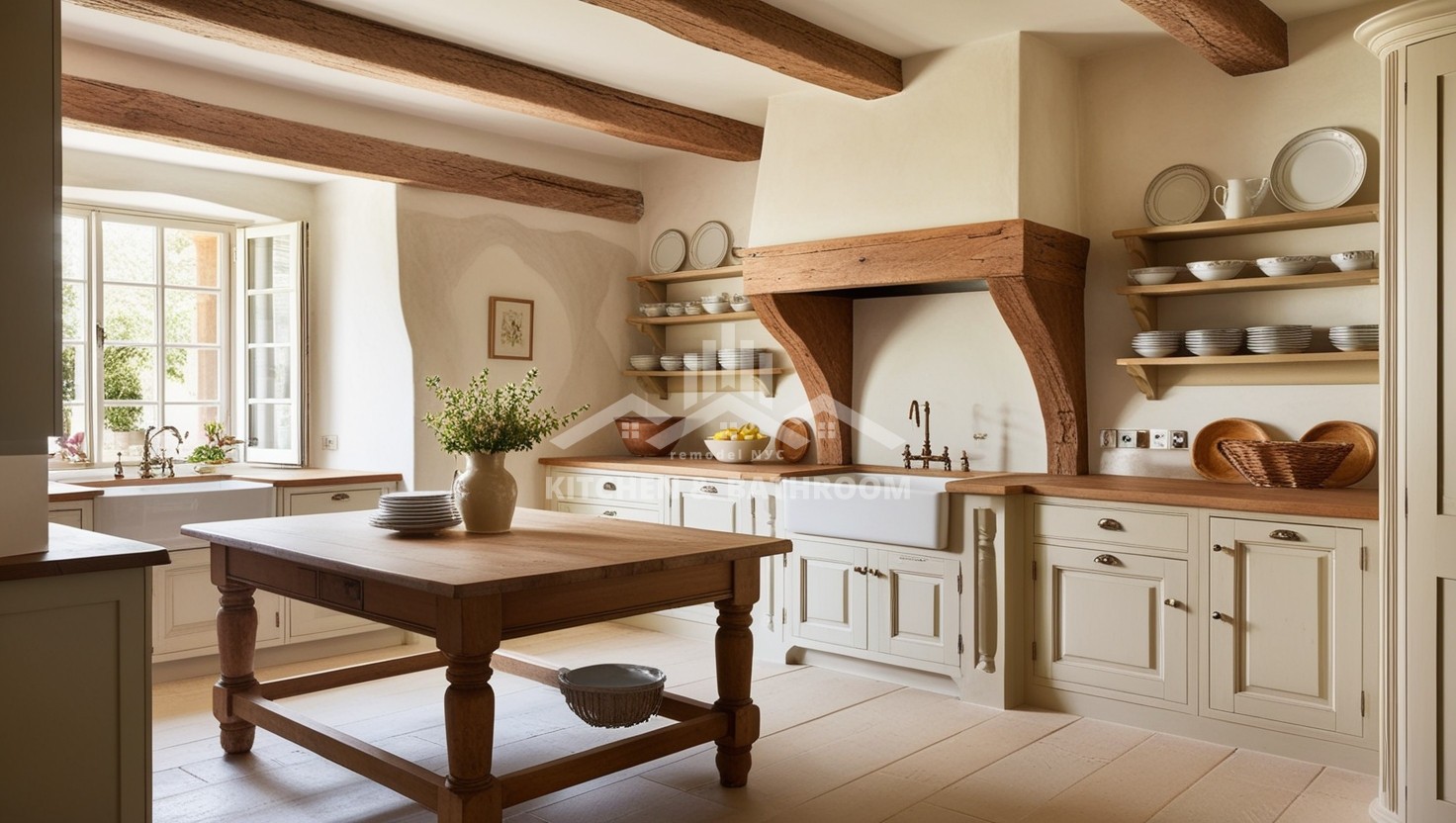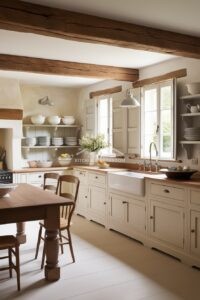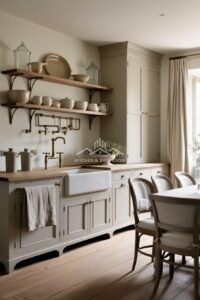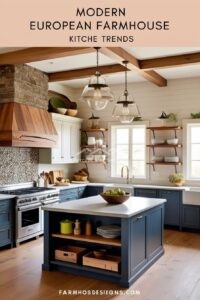
Timeless Decor Tips for Your European Farmhouse Kitchen
European farmhouse kitchen design is the perfect blend of rustic charm and timeless elegance, offering a cozy yet functional space that invites warmth and comfort. At Kitchen and Bathroom Remodeling, we specialize in creating beautiful kitchens that capture the essence of European farmhouse style. In this guide, we’ll share timeless decor tips that will help you transform your kitchen into a space that not only looks stunning but also functions seamlessly. Whether you’re planning a full remodel or looking to refresh your current space, these ideas will inspire you to achieve the classic appeal of a European farmhouse kitchen.
Essential Design Ideas for a Timeless European Farmhouse Kitchen
European farmhouse kitchen design is the epitome of timeless elegance blended with rustic charm. This kitchen style has become increasingly popular among homeowners who want to create a cozy, functional space that exudes both warmth and sophistication. With a focus on natural materials, vintage-inspired fixtures, and neutral color palettes, the European farmhouse kitchen is designed to stand the test of time.
At Kitchen and Bathroom Remodeling, based in E Northport, NY, 11731, we specialize in creating kitchens that blend the old-world charm of European countryside homes with modern conveniences. In this article, we’ll explore timeless decor tips, design ideas, and remodeling suggestions that will help you create your own European farmhouse kitchen.
Whether you’re undergoing a complete kitchen remodel or simply looking for ways to refresh your space, these tips and insights will guide you to achieve a classic, welcoming kitchen that never goes out of style.

What Defines a European Farmhouse Kitchen?
A European farmhouse kitchen is inspired by the traditional kitchens found in rural European homes. These kitchens prioritize practicality and warmth while showcasing natural materials, handcrafted elements, and vintage-inspired designs. The result is a space that feels both timeless and inviting—a kitchen that is functional yet exudes a sense of history and charm.
Key Elements of a European Farmhouse Kitchen:
- Natural Materials: Wood, stone, metal, and ceramics are essential materials in a European farmhouse kitchen. These elements are often left in their natural state to highlight their organic beauty. Think of reclaimed wood beams, natural stone countertops, and handmade ceramics.
- Neutral Color Palettes: The color scheme of a European farmhouse kitchen tends to be muted, with whites, creams, soft grays, and earthy tones dominating the palette. These colors create a calm and serene atmosphere that complements the rustic materials.
- Vintage-Inspired Fixtures: Faucets, light fixtures, and hardware in a European farmhouse kitchen are often vintage-inspired. Wrought iron, brass, and aged bronze are popular finishes that add to the old-world charm.
- Open Shelving: Instead of upper cabinets, many European farmhouse kitchens feature open shelving that allows homeowners to display beautiful dishes and glassware.
- Apron-Front Sinks: Also known as farmhouse sinks, these large, deep sinks are a staple of the style. They are functional and add a rustic, country vibe to the kitchen.

Timeless Decor Tips for Your European Farmhouse Kitchen
If you’re looking to create a European farmhouse kitchen, these timeless decor tips will help you achieve the perfect balance of rustic charm and modern functionality.
1. Use Reclaimed Wood for Warmth and Character
Reclaimed wood is a defining feature of the European farmhouse style. Whether it’s used for cabinetry, flooring, or ceiling beams, reclaimed wood adds warmth, texture, and a sense of history to the kitchen. Look for wood with visible knots, grains, and weathering for an authentic farmhouse feel.
- Ceiling Beams: Exposed wooden beams add architectural interest and a sense of grandeur to the kitchen. For a more rustic look, consider using reclaimed wood beams in a natural finish.
- Flooring: Reclaimed wood flooring provides a warm and inviting foundation for your kitchen. Opt for wide plank floors in a weathered finish to enhance the farmhouse aesthetic.
- Cabinetry: Reclaimed wood can also be used for your kitchen cabinets or as accents, such as the kitchen island or open shelving.
By using reclaimed wood, you’re not only adding aesthetic appeal but also contributing to sustainability by repurposing materials.
2. Incorporate Vintage or Antique Hardware
The hardware in a European farmhouse kitchen is often vintage-inspired or even antique. Cabinet pulls, knobs, and faucets made from materials like brass, bronze, or iron add a timeless touch to your kitchen. Opt for simple, classic designs like cup pulls, bin pulls, or vintage-style knobs.
- Brass Hardware: Brass is a popular choice for European farmhouse kitchens because it develops a beautiful patina over time, giving your kitchen a lived-in, timeless look.
- Iron or Bronze: For a more rustic feel, iron or bronze hardware can add a sense of history and durability to your kitchen design.
When selecting hardware, consider the finish and how it complements other elements in the kitchen, such as light fixtures and appliances.
3. Opt for Open Shelving to Showcase Beautiful Dishes
Open shelving is both functional and decorative in a European farmhouse kitchen. Instead of traditional upper cabinets, open shelving allows you to display your beautiful dishware, glassware, and decorative items. This not only makes your kitchen feel more open and spacious but also gives you the opportunity to showcase unique, handcrafted pieces.
- Wooden Shelving: Opt for wooden shelves with metal brackets for a classic farmhouse look. You can use reclaimed wood for added character or stained wood for a more polished appearance.
- Display Everyday Items: Open shelving should be both functional and beautiful. Arrange everyday items like plates, bowls, and glasses alongside decorative pieces like vases, candles, or small potted plants.
Remember to keep your open shelving organized and balanced. Too much clutter can detract from the simplicity and elegance of the design.
4. Invest in a Farmhouse Sink for a Classic Touch
The apron-front sink, commonly known as a farmhouse sink, is a signature feature of the European farmhouse kitchen. These deep, wide sinks are practical for washing large pots and pans while also adding a touch of rustic charm to your kitchen.
- Materials: Farmhouse sinks come in a variety of materials, including porcelain, fireclay, stainless steel, and copper. Porcelain and fireclay are popular choices for farmhouse kitchens due to their durability and classic look.
- Vintage-Style Faucet: Pair your farmhouse sink with a vintage-inspired faucet in a finish that complements the rest of your kitchen hardware. Options like brass, bronze, or matte black are timeless choices.
Farmhouse sinks are not only aesthetically pleasing but also highly functional, making them a great investment for your kitchen remodel.
5. Choose Natural Stone Countertops
Natural stone countertops, such as marble, granite, or soapstone, are the perfect complement to the European farmhouse kitchen. These materials add elegance and durability to your kitchen while enhancing the rustic, natural feel of the space.
- Marble: Marble is a classic choice for European kitchens, especially in light tones like Carrara or Calacatta. The natural veining in marble adds visual interest and a luxurious touch.
- Granite: Granite is another popular option due to its durability and variety of colors and patterns. Choose a honed or matte finish for a more rustic, lived-in look.
- Soapstone: Soapstone has a soft, matte finish that makes it a great choice for farmhouse kitchens. Its dark, rich color contrasts beautifully with lighter cabinetry and natural wood elements.
Natural stone countertops are not only beautiful but also long-lasting, making them a smart investment for your kitchen remodel.
6. Add Vintage-Inspired Lighting
Lighting plays a crucial role in setting the mood and ambiance of your kitchen. For a European farmhouse kitchen, vintage-inspired lighting fixtures can add warmth and character to the space.
- Pendant Lights: Hang pendant lights over the kitchen island or dining table for a stylish focal point. Look for fixtures with metal or glass shades in finishes like brass, copper, or wrought iron.
- Chandeliers: A vintage-style chandelier can add elegance to your kitchen while enhancing the farmhouse aesthetic. Choose a fixture with exposed bulbs or wrought iron detailing for an old-world feel.
- Wall Sconces: Wall sconces are another great option for adding ambient lighting to your kitchen. Install them above open shelving or around the perimeter of the room for a warm, inviting glow.
When selecting lighting fixtures, consider the size and scale of your kitchen. Oversized fixtures can create a dramatic effect, while smaller fixtures add subtle charm.
7. Incorporate Custom Details for a Personal Touch
One of the best ways to make your European farmhouse kitchen feel unique is by incorporating custom details that reflect your personal style. Custom cabinetry, range hoods, and built-in shelving can add both functionality and beauty to your kitchen.
- Custom Cabinetry: Custom cabinets with inset doors, beadboard detailing, or glass fronts can add a touch of elegance and craftsmanship to your kitchen. Opt for soft-close drawers and pull-out shelves for added convenience.
- Custom Range Hood: A custom range hood made from reclaimed wood, metal, or plaster can serve as a stunning focal point in your kitchen. Pair it with a professional-grade range for both style and performance.
- Built-In Shelving: Built-in shelving or cabinets can add extra storage and display space while keeping the kitchen organized and clutter-free. Use the shelves to display cookbooks, decorative plates, or family heirlooms.
Custom details not only enhance the look of your kitchen but also make it more functional and tailored to your needs.
8. Create a Cozy Breakfast Nook
A European farmhouse kitchen is all about creating a warm and inviting space. Adding a cozy breakfast nook with a rustic wooden table and upholstered chairs or benches can make your kitchen feel more intimate and welcoming.
- Natural Materials: Use natural materials like wood, linen, and cotton for your breakfast nook furniture and upholstery. A rustic wooden table paired with cushioned chairs or a bench will create a cozy, farmhouse feel.
- Soft Lighting: Add a pendant light or chandelier above the breakfast nook to create a warm and inviting atmosphere. Opt for a fixture with a vintage or industrial look to enhance the farmhouse aesthetic.
- Decorative Accents: Complete the look with decorative accents like potted plants, candles, or a vase of fresh flowers. These small touches will make the space feel cozy and lived-in.
A breakfast nook is the perfect spot for family meals, morning coffee, or casual gatherings with friends.
9. Use a Neutral Color Palette with Earthy Accents
The color palette in a European farmhouse kitchen is typically neutral, with whites, creams, soft grays, and earthy tones creating a calm and serene atmosphere. These colors complement the natural materials used in the kitchen, such as wood, stone, and metal.
- White and Cream: White and cream are classic choices for farmhouse kitchens. These light, neutral colors make the space feel bright and airy while allowing the natural materials to stand out.
- Gray and Taupe: Soft grays and taupes add depth and sophistication to the kitchen. Use these colors for cabinetry, walls, or accents to create a more muted, timeless look.
- Earthy Tones: Incorporate earthy tones like sage green, muted blues, and warm browns to add contrast and warmth to the space. These colors can be used for cabinetry, countertops, or decorative accents.
By sticking to a neutral color palette with earthy accents, you’ll create a timeless and cohesive look that will never go out of style.
10. Install Classic Windows & Doors
Classic windows and doors are essential for capturing the old-world charm of a European farmhouse kitchen. Large windows that let in natural light, along with doors that feature traditional or vintage-inspired designs, enhance the rustic and welcoming feel of the space.
- Windows: Large, divided-light windows are a hallmark of European farmhouse kitchens. These windows not only provide ample natural light but also create a connection between the kitchen and the outdoors.
- Barn Doors: Sliding barn doors or Dutch doors add a rustic touch to the kitchen while also serving a functional purpose. Barn doors are a great option for pantry doors or entryways between the kitchen and other areas of the house.
- French Doors: French doors with divided panes and glass panels can add elegance and charm to the kitchen. These doors are perfect for connecting the kitchen to an outdoor patio or dining area.
Classic windows and doors not only enhance the aesthetic of your kitchen but also create a more functional and light-filled space.

Kitchen Remodeling Ideas for 2024
As we move into 2024, several kitchen design trends are emerging that pair beautifully with the timeless European farmhouse kitchen style. Here are some remodeling ideas to consider as you plan your kitchen renovation.
1. Bold Backsplashes
While the overall color palette in a European farmhouse kitchen is neutral, adding a bold backsplash in a patterned tile or rich color can create a stunning focal point. Consider using handmade tiles or traditional European patterns to add a unique touch.
- Patterned Tiles: Choose tiles with intricate patterns or geometric designs to create visual interest. Look for tiles in shades of blue, green, or terracotta to add color while maintaining the farmhouse aesthetic.
- Subway Tiles: Classic subway tiles in a glossy finish are a timeless option for farmhouse kitchens. Arrange them in a herringbone or vertical pattern for a modern twist.
A bold backsplash can add personality and character to your kitchen while still maintaining the timeless farmhouse look.
2. Mixed Materials for Depth and Contrast
Mixing materials like wood, stone, metal, and glass adds depth and interest to your kitchen design. For example, you can pair natural stone countertops with a reclaimed wood island and metal barstools for a layered, cohesive look.
- Wood and Stone: Combine reclaimed wood beams with natural stone countertops for a rustic yet sophisticated kitchen.
- Metal and Glass: Incorporate metal light fixtures, hardware, and barstools to add an industrial edge to your farmhouse kitchen. Glass-front cabinets or open shelving with glass accents can lighten the overall look.
By mixing materials, you’ll create a dynamic and visually interesting kitchen that feels both rustic and modern.
3. Sustainable Choices for an Eco-Friendly Kitchen
Sustainability is a significant trend in 2024, and incorporating eco-friendly materials like reclaimed wood, recycled stone, and energy-efficient appliances is a great way to make your kitchen more environmentally conscious without sacrificing style.
- Reclaimed Materials: Use reclaimed wood for flooring, cabinetry, or furniture to reduce waste and add character to your kitchen.
- Energy-Efficient Appliances: Invest in energy-efficient appliances, such as refrigerators, dishwashers, and ovens, to reduce your kitchen’s carbon footprint.
Creating a sustainable kitchen not only benefits the environment but also adds long-term value to your home.
4. Hidden Storage Solutions for a Clean, Uncluttered Look
Efficient storage solutions are always in demand, and hidden storage options like pull-out pantry shelves, built-in cabinets, and concealed appliances are perfect for maintaining the clean, uncluttered look of a European farmhouse kitchen.
- Pull-Out Shelves: Install pull-out shelves in your pantry or cabinets to maximize storage space and make it easier to access items.
- Appliance Garages: Appliance garages allow you to conceal small appliances like toasters and blenders, keeping your countertops clear and clutter-free.
Hidden storage solutions help keep your kitchen organized and functional while preserving the timeless aesthetic of the farmhouse style.
5. Statement Islands as a Focal Point
A large kitchen island can serve as the centerpiece of your kitchen. For a European farmhouse kitchen, opt for a rustic wooden island with plenty of storage and seating. You can also add decorative details like corbels or a beadboard panel for extra charm.
- Storage and Seating: Choose an island with built-in storage, such as drawers, shelves, or cabinets, to maximize functionality. Add bar stools or chairs for casual dining or entertaining.
- Decorative Accents: Add corbels, beadboard, or paneling to the island to enhance the farmhouse look. You can also opt for a contrasting countertop material, such as butcher block or marble, to create a visual focal point.
A statement island not only provides additional workspace and storage but also serves as a gathering place for family and friends.
FAQ’s European Farmhouse Kitchen
What defines a European farmhouse kitchen?
A European farmhouse kitchen combines rustic charm with modern functionality. It typically features natural materials like wood and stone, a neutral color palette, vintage-inspired fixtures, and cozy, welcoming decor.
How can I make my kitchen look like a European farmhouse?
To achieve a European farmhouse kitchen, incorporate natural materials, vintage-inspired hardware and fixtures, open shelving, an apron-front sink, and a neutral color palette. Adding personal touches like reclaimed wood and custom details will enhance the look.
Are European farmhouse kitchens still in style?
Yes, European farmhouse kitchens remain popular due to their timeless design, cozy atmosphere, and practical features. By blending rustic elements with modern amenities, this style appeals to homeowners looking for a warm and inviting kitchen that will stand the test of time.
What is the difference between a farmhouse kitchen and a European farmhouse kitchen?
While both styles emphasize rustic charm, a European farmhouse kitchen incorporates more traditional European elements, such as vintage-inspired fixtures, neutral color palettes, and a focus on natural materials like wood and stone. American farmhouse kitchens tend to be more casual and often include more modern, industrial elements.
What are the best countertops for a European farmhouse kitchen?
Natural stone countertops, such as marble, granite, and soapstone, are ideal for a European farmhouse kitchen. These materials are not only beautiful and durable but also complement the rustic, timeless aesthetic of the style.
Conclusion
Creating a European farmhouse kitchen is about blending rustic charm with modern convenience to achieve a space that feels warm, inviting, and timeless. By incorporating natural materials, vintage-inspired fixtures, and neutral color palettes, you can transform your kitchen into a beautiful, functional space that will stand the test of time.
At Kitchen and Bathroom Remodeling in E Northport, NY, 11731, we specialize in custom kitchen remodeling, including the European farmhouse kitchen style. Whether you’re looking for ideas to update your current kitchen or planning a full remodel, our team is here to help bring your vision to life. Contact us today to discuss your project and start creating the kitchen of your dreams!